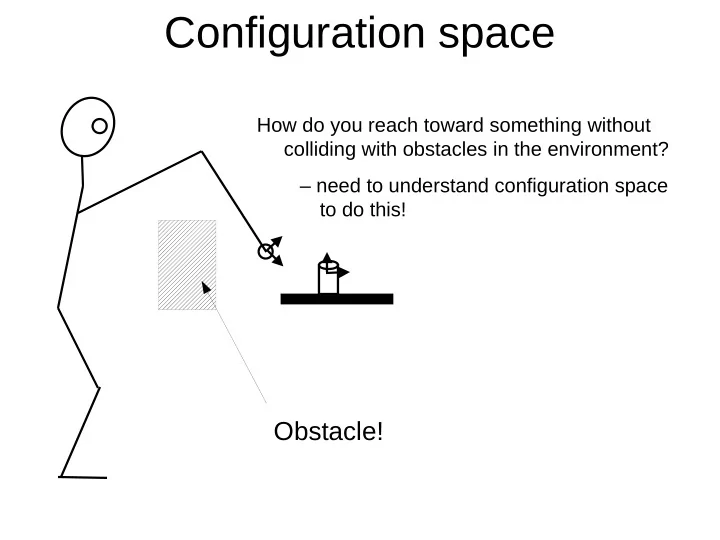

Configuration space How do you reach toward something without colliding with obstacles in the environment? – need to understand configuration space to do this! Obstacle!
Problem we want to solve Given: – description of the robot arm (the manipulator) – description of the obstacle environment Find: – path from start to goal that does result in a collision Starting configuration Goal configuration
Problem we want to solve This problem statement is actually very general – manipulators
Problem we want to solve This problem statement is actually very general – manipulators – mobile robots
Approach: plan in “configuration space” Convert the original planning problem into a planning problem for a single point.
Approach: plan in “configuration space” Convert the original planning problem into a planning problem for a single point. workspace configuration space Original problem Equivalent problem: – plan path for robot arm – plan path for a point
Approach: plan in “configuration space” Notice the axes! workspace configuration space Cartesian space! Joint angles!
Approach: plan in “configuration space” workspace configuration space Every point here corresponds to a single robot configuration here
Approach: plan in “configuration space” workspace configuration space Every point that intersects an obstacle here corresponds to an arm configuration that intersects an obstacle
Approach: plan in “configuration space” workspace configuration space C-obstacles Free space
Configuration space The dimension of a configuration space is the minimum number of parameters needed to specify the configuration of the robot completely. – also called the number of “degrees of freedom” (DOFs) Dimension = 3
Configuration space The dimension of a configuration space is the minimum number of parameters needed to specify the configuration of the robot completely. – also called the number of “degrees of freedom” (DOFs) Dimension = ?
Topology of configuration space What is topology? – the properties of space that are preserved under continuous deformations, such as stretching and bending, but not tearing or gluing The topology of this mug is a torus
Topology of configuration space What is topology? – the properties of space that are preserved under continuous deformations, such as stretching and bending, but not tearing or gluing Torus:
Topology of configuration space What is topology? – the properties of space that are preserved under continuous deformations, such as stretching and bending, but not tearing or gluing Cylinder:
Topology of configuration space What is topology? – the properties of space that are preserved under continuous deformations, such as stretching and bending, but not tearing or gluing Configuration space:
Topology of configuration space What is topology? – the properties of space that are preserved under continuous deformations, such as stretching and bending, but not tearing or gluing q 2 q 2 q 1 q 1 Configuration space:
Paths in c-space A path is a function from the unit interval onto configuration space: = start of path = end of path = somewhere in between... A path
Homotopic paths Two paths are homotopic if it is possible to continuously deform one into the other
Homotopic paths How many homotopic paths are their between these two points?
Homotopic paths How many homotopic paths are their between these two points?
Homotopic paths How many homotopic paths are their between these two points?
Homotopic paths Two paths are homotopic if it is possible to continuously deform one into the other
Connectedness of c-space C is connected if every two configurations can be connected by a path. C is simply-connected if any two paths connecting the same endpoints are homotopic. Otherwise C is multiply-connected.
Recommend
More recommend